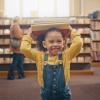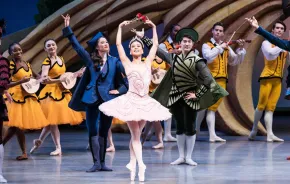
Nathan Sawaya is a serious artist whose sculptures explore themes of creativity and fulfillment. They comment on art history, reinterpreting iconic paintings in three dimensions and contrasting classical traditions with common materials. Or rather, one common material — all of Sawaya's artworks are made of Lego bricks.
Sawaya's material of choice reminds adults and assures children that creativity is a necessary and universal part of human life. A Mona Lisa or Starry Night made of Legos? A child can tell you what that means: Great art is not precious.

The Art of the Brick, an exhibit of Sawaya's work that opens at Pacific Science Center this weekend, is a career-spanning exhibition divided into eight galleries. The first few galleries recreate the syllabus of Art History 101 in bricks. The works range from Lego renditions of classic paintings to more sculptural pieces that seem to represent the models for paintings rather than the paintings themselves (including a 3-D recreation of Klimt’s famously flat The Kiss) to — finally — Lego reproductions of famous bronzes and terracotta warriors.
Each visitor is invited to take one brick, sign it with a Sharpie, and add it to the collaborative artwork, putting into practice Sawaya’s central message: Creativity is for everyone.
Further into the galleries, the works become less referential, instead presenting physical forms that interpret emotional themes very literally. A bright red human figure pulls away from grey hands that would hold him back. An outline of a human body is accompanied by the message, “When we’re born, we’re all given a shell to live in. And one of the joys of living is being able to fill it any way we want.”
One gallery exhibits the collaboration between Sawaya and photographer Dean West. Realistic photographs show a man with a Lego umbrella in the pouring rain, a woman walking a Lego dog. The Lego pieces are displayed in the same gallery as the photographs. The end result for kids is almost like a "Find the hidden picture" game in Highlights magazine.
Around the corner, eight almost life-size orange salmon swim against a photographic background. A ninth, rainbow-colored, swims higher and in an opposite direction. This piece, titled "Be Different,” was made specifically for this stop on the exhibition’s tour and will remain at Pacific Science Center when the exhibition moves on.

Hands-off but child-friendly
For kids, a challenge of viewing the exhibition is that they can't do what they most want to do with Lego bricks — touch and build. If your child normally has a hard time with the "Look with your eyes not with your hands” rule, you might want to pass on this exhibit.
But the good news is that the exhibit is designed to be accessible to kids. The sculptures themselves can be understood on multiple levels, and the presentation is always child-friendly, starting with the short video introducing visitors to the artist. Often kids are inclined to rush from one display to another in museums, assuming (often correctly) the written parts are for adults. Not so at this exhibition. Encourage your kids to at least read about their favorite pieces. It will really help them engage with the art more deeply.

And kids will be rewarded for their restraint in keeping hands to themselves at the end of the exhibit. There, a green man sits in a chair. The chair next to him is empty, offering both a seat and a photo op. Nearby, a bucket of bricks stands next to a table with a work in progress. Each visitor is invited to take one brick, sign it with a Sharpie, and add it to the collaborative artwork, putting into practice Sawaya’s central message: Creativity is for everyone.
Note: To prepare for the exhibition, you might want to read more about Nathan Sawaya on his website. The award-winning artist, a native Washingtonian (he was born in Colville, Wash.), was the first contemporary artist to bring Lego works into the art world as a medium. He is also the founder of The Art Revolution Foundation, which aims to make art a priority in schools and homes — its mantra is "Art is not optional."
Surviving the Lego gift shop
Not suprisingly, the exit from the exhibition passes through a Lego shop where and the walls are lined with Lego kits, keychain characters from the Lego movie, and T-shirts featuring images from the exhibit. Even if you are usually immune to costly extras, The Art of the Brick will leave your whole family with a need to build. Be prepared to buy, or withstand pleas for purchases.
A hardback book of the exhibit guide costs $29.95 and includes images of almost every piece on display.
If you go...
Where and when: Pacific Science Center, 200 Second Ave N, Seattle through September 11.
Exhibit timing: Entrance is on a first-come, first-served basis beginning at 10 a.m. daily. Guests will be let inside in groups to begin their experience with an introductory video. Allow about one hour to view the entire exhibit. There is no re-entry after you leave the exhibit (though you can re-enter Pacific Science Center on the same day). Pacific Science Center estimates it takes about an hour to go through the exhibit.
Tickets (which includes general exhibit admission): adults $28.75; seniors (65+): $26.75; youth (6-15) $23.75; child (3-5) $20.75; members (all ages) $7. (It might be a good time to consider a family membership, $109 annually.) Buy tickets online.
Best days to visit: Weekdays and non-holiday weekends will obviously be the least-crowded days to visit, if you can wait that long.
Restrooms: There are no restrooms located inside the exhibit; PSC recommends using the restroom prior to entering.
Parking: There is no free parking near Seattle Center. Street parking is limited to two hours ($3) or 4 hours ($6). Seattle Center operates several parking garages.
Transportation: Taking light rail downtown and transferring to the monorail at the Westlake Station may be faster and cheaper than driving.











